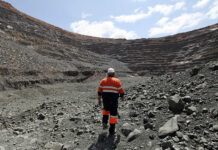
[miningmx.com] — JOHANN Rupert is back in the diamond mining business after effectively getting out of it last year when Remgro unbundled its 29% stake in Trans Hex.
He has teamed up with independent miners Chris Potgieter and Chris Kimber to recover diamonds from surface dumps at the former Jagersfontein mine in the Free State.
The new venture is being run through Luxembourg-listed Reinet Investment.
In reply to emailed questions, Rupert said: “This deal should be seen in conjunction with bigger investments that have already been concluded in other hard assets/hedging deals.’
The secretive Potgieter runs SA’s largest, privately-owned alluvial diamond mining company called Sonop Diamond Mining. In its heyday it was almost as big as the SA operations of Trans Hex, although it was badly affected by the 2008/9 collapse of the diamond market .
Kimber is a director of black economic empowerment (BEE) mining company Superkolong. This heads up the Superkolong consortium, which acquired the Jagersfontein dumps from De Beers in September for an undisclosed amount.
Kimber declined to comment when approached.
Diamond industry sources say a new company called Jagersfontein Development has now been set up in which Reinet, Superkolong and Sonop will be partners, although the respective shareholdings have not yet been finalised.
Reinet is providing the funding, with sources saying it will invest around R600m.
Rupert said the amount to be invested “will depend on the final needs but the equity exposure will be less than 3% of Reinet’s net asset value. It will be a combination of equity and shareholders’ loans.’
The sources indicated that Jagersfontein had also acquired the right to mine alluvial diamonds on De Beers’ Rooipoort farm near Kimberley. But Rupert denied this, stating :”Rooipoort is a separate proposition.’
De Beers spokesperson Tom Tweedy said the Rooipoort deal was directly with Reinet and involved the creation of a special purpose vehicle (SPV) which made provision for BEE parties.
Retreatment of material from the Jagersfontein dumps is now about to start, following the relocation to the mine of the treatment plant from Potgieter’s Elsie’s Drift alluvial operation.
At full output the Jagersfontein plant is expected to produce up to 28,000 carats of diamonds a month at an average value of $146 per carat, generating annual revenues of around $50m.
The dump resource at Jagersfontein is estimated at 57 million tonnes (mt) at a grade of between 11 and 14 carats per hundred tons of material. The economic life of the operation is estimated at 18 years.
According to a diamond industry source, “there are no better diamond bearing dumps anywhere else in the world. Jagersfontein operated between about 1870 and 1970 and was known for producing high-value stones.’
The source added the 57mt dump resource excluded extensive volumes of untreated “floors’ – kimberlite ore mined and then laid out on surface to be allowed to weather before treatment but which was never actually treated.
Rooipoort is a conservation area on a par with many of the country’s national parks, and De Beers has owned it since 1893. During the 1980s De Beers fought off approaches by the South African National Parks Board to acquire Rooipoort.
Sections of Rooipoort are open to the public as part of the Diamond Route ecotourism programme that De Beers has developed on its various properties.
The farm covers about 40,000 hectares (ha) and has 32 km of riverine habitat along the Vaal River, which is where the alluvial diamond mining operations would take place.
According to sources, the mining right covers about 22,000ha but De Beers reckons “the mineralised area accounts for under 10% of the surface area’.
While the structure of the SPV is not confirmed at this stage, diamond sources reckon it’s Potgieter who will be doing the mining. This must worry De Beers, given Potgieter’s notorious reputation for poor rehabilitation work.
But Potgieter’s supporters reckon he has changed radically in recent years and has become more “holistic’ in his outlook.
Tweedy said: “Environmental rehabilitation was uppermost in our mind when we searched for a mining partner for Rooipoort.
“We have a contractual commitment that the Reinet SPV will rehabilitate the mining areas comparable to the best standards of De Beers.
“Due to the restricted size in terms of surface area and the locality of the alluvial gravels, we are confident that we will be able to manage the mining activity in such a manner that the impact on the Diamond Route activity will be minimised.’
De Beers isn’t saying it, but having Johann Rupert’s reputation on the line at Rooipoort has to be a huge advantage from an environmental standpoint.
The Rupert family has a long and close association with the World Wide Fund for Nature (WWF). and Rupert himself has just featured prominently for his vehement opposition to Shell’s proposed gas “fracking’ in the Karoo.











